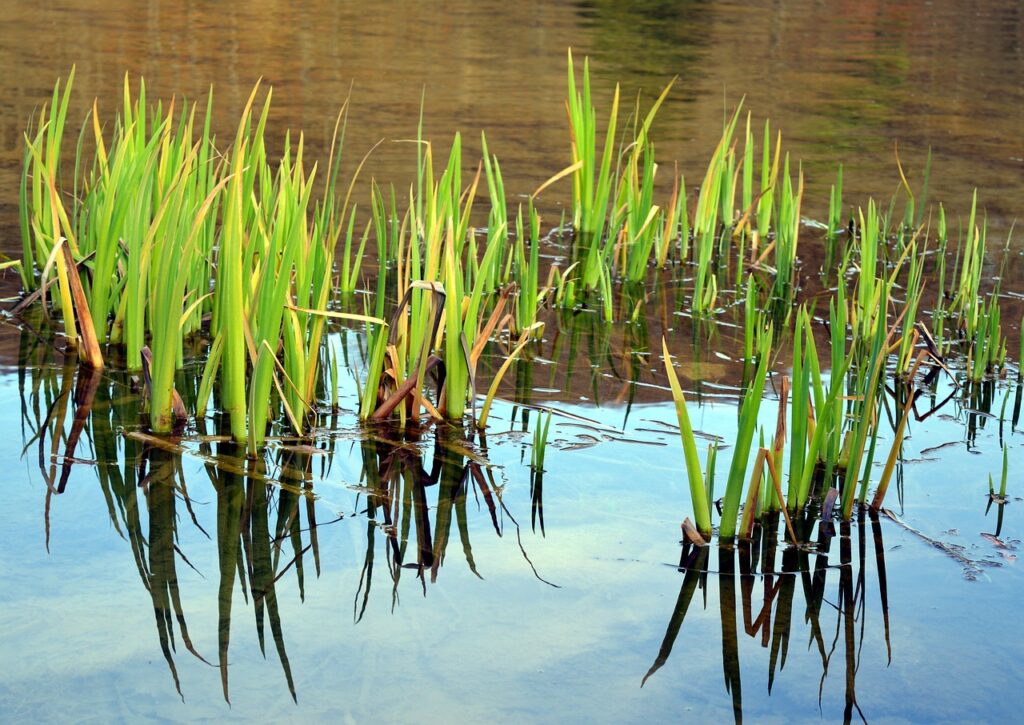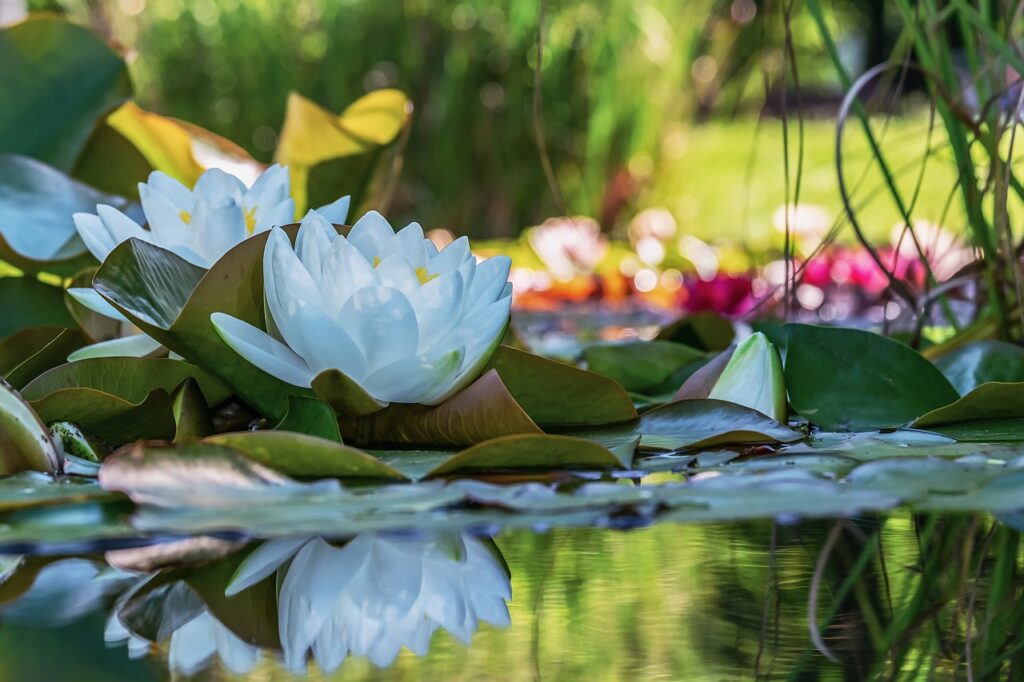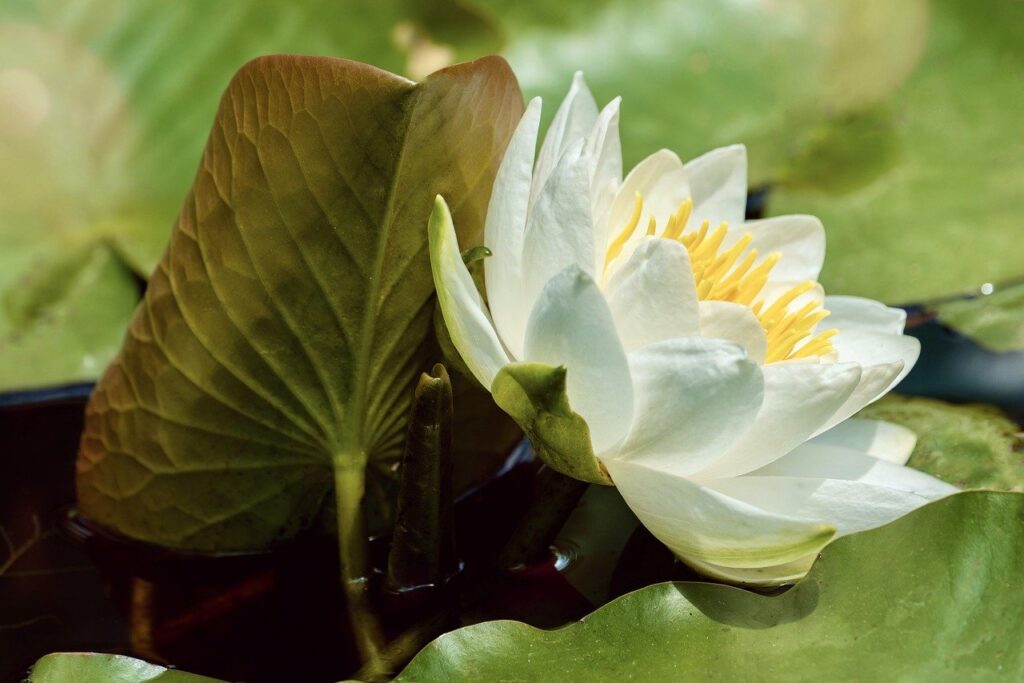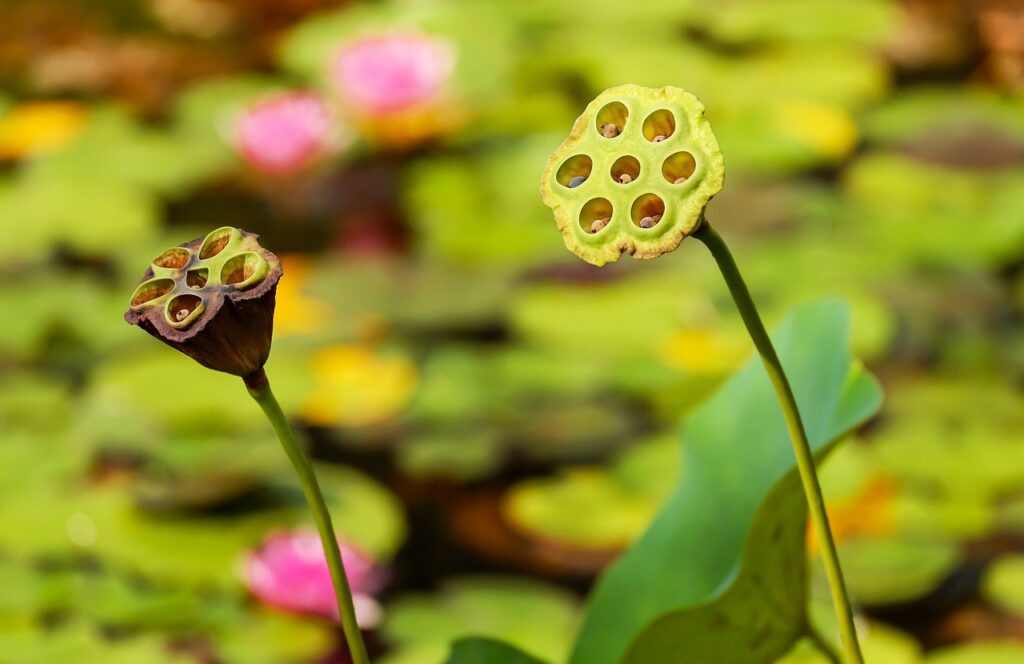Imagine transforming your fish pond into a lush oasis, where your fish thrive in clear, oxygen-rich water. If you’re wondering how to achieve this naturally, look no further. We are going to unveil the secrets of what plants oxygenate a fish pond naturally, ensuring the health and vitality of your underwater friends.
From the floating beauty of water lettuce to the vibrant submerged leaves of hornwort, you will discover a variety of flora that not only add a touch of serenity to your pond but also provide an essential oxygen boost. Get ready to dive into the world of aquatic plants and optimize your fish pond’s natural oxygenation.

Submerged Plants
Types of Submerged Plants
Submerged plants, also known as oxygenating plants, are aquatic plants that spend their entire life submerged in water. They play a vital role in maintaining a healthy fish pond ecosystem. There are several types of submerged plants that you can consider for your pond:
- Anacharis: Also known as waterweed, Anacharis is a popular choice for fish ponds. It has long, branching stems covered in bright green leaves. Anacharis is a great oxygenator and provides excellent hiding spots for fish.
- Hornwort: Hornwort is another common submerged plant that helps oxygenate the water. It has thin, green, and feathery leaves that create a beautiful underwater habitat. Hornwort is easy to grow and requires minimal maintenance.
- Vallisneria: Vallisneria, or eelgrass, is a submerged plant with long, ribbon-like leaves. It grows easily in both still and flowing water and provides an excellent hiding place for fish. Vallisneria also helps in reducing algae growth by competing for nutrients.
Benefits of Submerged Plants
Having submerged plants in your fish pond offers numerous benefits. Here are some of the advantages:
- Oxygenation: Submerged plants produce oxygen as a by product of photosynthesis, replenishing the dissolved oxygen levels in your pond. This is crucial for the health of your fish and other aquatic creatures.
- Habitat and Shelter: Submerged plants create a habitat for small aquatic organisms and provide shelter for fish, especially during their breeding and spawning periods. These plants offer protection from predators and create a conducive environment for fish to thrive.
- Algae Control: Submerged plants compete with algae for nutrients, sunlight, and space, thereby reducing the growth of unwanted algae. They play a significant role in maintaining water clarity and preventing excessive algae blooms.
Examples of Submerged Plants
If you are looking for specific examples of submerged plants to add to your fish pond, here are a few popular options:
- Water Hyacinth: Water Hyacinth is a beautiful floating plant that can also be submerged partially. It produces long, glossy green leaves and adds a stunning aesthetic appeal to your pond.
- Water Lettuce: Water Lettuce is another floating plant that can be partially submerged. It has rosettes of light green leaves and creates a charming floating mat on the water’s surface.
- Duckweed: Duckweed is a tiny floating plant that spreads rapidly and provides excellent shade and cover for fish. It is a favorite food source for many fish species as well.

Floating Plants
Types of Floating Plants
Floating plants are plants that naturally float on the water’s surface, deriving their nutrients directly from the water. They add beauty and diversity to your fish pond ecosystem. Here are some types of floating plants you can consider:
- Water Lily: Water lilies are perhaps the most recognizable of all floating plants. They have large, vibrant flowers that float on the water’s surface, while their leaves provide shade and cover for fish. Water lilies come in a variety of colors, making them a beautiful addition to any fish pond.
- Water Hawthorn: Water Hawthorn is a unique floating plant that produces delicate white or pink flowers. Their fragrance is delightful, and they bloom during cooler months, adding beauty to your pond when many other plants are dormant.
- Azolla: Azolla, also known as mosquito fern, is a small floating plant that forms a thick mat on the water’s surface. It not only adds visual interest to your pond but also helps in nitrogen fixation, improving water quality.
Benefits of Floating Plants
Incorporating floating plants into your fish pond brings numerous benefits. Let’s explore some of them:
- Shade and Surface Cover: Floating plants provide shade for your fish, helping to regulate the water temperature and prevent overheating. They also cover the water’s surface, reducing sunlight penetration and minimizing the growth of algae.
- Natural Filtration: Floating plants act as natural filters, absorbing excess nutrients, such as nitrates and phosphates, from the water. This helps reduce the risk of algae blooms and improves overall water quality in your pond.
- Aesthetic Appeal: Floating plants add a touch of natural beauty to your fish pond. The colorful flowers and lush foliage create a visually pleasing oasis, enhancing your enjoyment of the pond and creating a more attractive landscape.
Examples of Floating Plants
If you’re interested in adding floating plants to your fish pond, here are a few examples to consider:
- Water Poppy: Water Poppy is a floating plant with attractive yellow flowers that add a pop of color to your pond. It prefers calmer water conditions and can transform your pond into a stunning visual centrepiece.
- Frogbit: Frogbit is a floating plant that produces circular leaves and small, white flowers. It is an excellent oxygenator and helps maintain water clarity by competing with algae for nutrients.
- Salvinia: Salvinia is a floating fern with small, floating leaves that create a dense mat on the water’s surface. It provides shade, reduces evaporation, and can help control algae growth.
Marginal Plants
Types of Marginal Plants
marginal plants are aquatic plants that primarily grow around the edges or shallow areas of ponds. They thrive in moist soil or shallow water, adding beauty and stability to the pond’s ecosystem. Here are some types of marginal plants to consider:
- Cattails: Cattails are tall, iconic plants that grow near the water’s edge. They have long, cylindrical flower spikes and broad, strap-like leaves. Cattails provide valuable habitat for birds and other wildlife and are effective at filtering pollutants from the water.
- Pickerel Weed: Pickerel Weed is a vibrant flowering plant that thrives in the shallow margins of ponds. It produces tall spikes of blue or purple flowers, attracting pollinators and adding a splash of color to your pond.
- Sweet Flag: Sweet Flag, also known as calamus, is a unique marginal plant with tall, sword-like leaves. It has a pleasant fragrance and can be used for erosion control along the edges of your pond.
Benefits of Marginal Plants
Including marginal plants in your fish pond offers several benefits. Let’s explore some of the advantages:
- Erosion Control: Marginal plants help stabilize the perimeter of your pond by preventing soil erosion. Their extensive root systems hold the soil together, helping to protect against erosion caused by water movement.
- Habitat Creation: Marginal plants provide habitat and food sources for a wide range of wildlife, including birds, butterflies, and beneficial insects. They attract pollinators, contribute to biodiversity, and create a thriving ecosystem.
- Water Purification: Marginal plants act as natural biofilters, absorbing excess nutrients and pollutants from the water. They play a vital role in improving water quality and reducing the risk of algal blooms.
Examples of Marginal Plants
If you’re considering incorporating marginal plants into your fish pond, here are a few examples to consider:
- Iris: Irises are a popular choice for pond margins due to their stunning flowers and ornamental grass-like foliage. They come in various colors and add a touch of elegance to any pond.
- Taro: Taro, also known as elephant ear, is a tropical marginal plant with large, heart-shaped leaves. It thrives in moist soil or shallow water and creates a dramatic focal point with its impressive foliage.
- Bog Bean: Bog Bean is an aquatic perennial with attractive tripartite leaves. It produces delicate white flowers that add a subtle charm to the water’s edge. Bog Bean is excellent for attracting butterflies and other insects.

Emergent Plants
Types of Emergent Plants
Emergent plants, also known as shoreline or shallow water plants, are aquatic plants that grow along the edges of ponds or in shallow water. They are rooted in the soil underwater but rise above the water level, adding vertical interest to your fish pond. Here are some types of emergent plants:
- Canna Lily: Canna Lily is a stunning emergent plant known for its vibrant flowers and tropical foliage. It produces large, showy blooms in various colors, making it a favorite choice for many pond owners.
- Rushes: Rushes are tall, slender plants with cylindrical stems and grass-like leaves. They provide vertical accents and create a sense of structure along the pond’s edge. Rushes are also effective erosion controllers.
- Sedges: Sedges are similar to rushes but have triangular stems and coarse, grass-like foliage. They come in various heights and add texture and depth to the pond’s edge.
Benefits of Emergent Plants
Incorporating emergent plants into your fish pond offers several benefits. Let’s explore some of the advantages:
- Wildlife Habitat: Emergent plants provide a natural habitat for various wildlife species, including birds, frogs, turtles, and dragonflies. They offer shelter, nesting sites, and food sources, creating a dynamic and diverse ecosystem.
- Water Quality Management: Emergent plants play a crucial role in maintaining water quality by absorbing excess nutrients from the water. They act as natural filters, reducing the risk of nutrient imbalances and algal blooms.
- Aesthetic Appeal: Emergent plants add beauty and visual interest to your pond. Their tall, graceful forms create a sense of tranquility and provide an attractive backdrop for other plants and wildlife.
Examples of Emergent Plants
If you’re looking to add emergent plants to your fish pond, here are a few examples to consider:
- Blue Flag Iris: Blue Flag Iris is a stunning emergent plant with iris-like flowers that range in color from deep blue-purple to yellow. It thrives in wet soil or shallow water and adds a touch of elegance to the pond’s edge.
- Arrowhead: Arrowhead, also known as duck potato, is a native emergent plant with arrow-shaped leaves and white or pink flowers. It is a favorite food source for waterfowl and adds a natural charm to any pond.
- Marsh Marigold: Marsh Marigold is a spring-blooming emergent plant with bright yellow flowers. It prefers damp soil or shallow water and creates a cheerful display along the pond’s edge.

Plant Care Tips
Choosing the Right Plants
When selecting plants for your fish pond, it’s essential to choose species that are suitable for your specific climate and water conditions. Consider the following factors:
- Hardiness: Choose plants that are suitable for your climate zone to ensure they can withstand the temperature fluctuations throughout the year.
- Light Requirements: Determine the amount of sunlight your pond receives to select plants that match the light conditions. Some plants thrive in full sun, while others prefer partial shade.
- Water Depth: Different plants have specific water depth requirements. Ensure that you choose plants that are appropriate for the depth of your pond.
Planting Techniques
Proper planting techniques are crucial for the successful establishment of aquatic plants in your fish pond. Follow these guidelines:
- Prepare the Soil: Before planting, prepare the soil by removing any debris or weeds. Loosen the soil to provide a healthy growing environment for the plants.
- Container Planting: If planting potted plants, choose containers specifically designed for aquatic planting. Fill the containers with aquatic soil and gently place the plants in position. Cover the soil surface with decorative gravel to prevent soil erosion.
- Direct Planting: For bare-root plants, gently lower the plants into the appropriate depth of water or soil. Ensure the roots are properly covered, and gently firm the soil around them.
Maintenance and Care
To ensure the health and vitality of your fish pond plants, regular maintenance and care are essential. Consider the following tasks:
- Pruning and Trimming: As plants grow, they may require periodic pruning and trimming to maintain their desired size and shape. Remove any dead or decaying plant material to prevent rot and disease.
- Fertilization: Some aquatic plants benefit from regular fertilization. Choose a fertilizer specifically formulated for pond plants and follow the recommended dosage to promote healthy growth.
- Weed Control: Regularly inspect your pond for any invasive or unwanted plant species. Promptly remove any weeds to prevent them from overtaking your desired plants.
Creating a Balanced Ecosystem
The Role of Plants in Pond Ecology
Plants play a vital role in creating a balanced ecosystem in your fish pond. Here’s how they contribute to the overall health of the pond:
- Oxygenation: Through photosynthesis, plants produce oxygen, maintaining healthy oxygen levels in the water. This is essential for the respiration of fish and other aquatic organisms.
- Nutrient Uptake: Plants absorb excess nutrients from the water, including nitrogen and phosphorus, which are essential for algae growth. By reducing nutrient availability, plants help control algae blooms and improve water clarity.
- Habitat Creation and Protection: The presence of plants provides important habitat and shelter for fish, frogs, insects, and other wildlife. They offer protection from predators, nesting sites, and food sources, enhancing the overall biodiversity of the pond.
Combining Different Types of Plants
To create a diverse and visually appealing pond ecosystem, consider combining different types of plants. Incorporate a mix of submerged, floating, marginal, and emergent plants to maximize the benefits they offer. This combination will create a balanced habitat and provide a range of habitats for various organisms.
Maintaining Water Quality
Proper maintenance of water quality is vital for the overall health of your fish and plants. Here are some measures you can take to maintain water quality:
- Regular Water Testing: Regularly test the water parameters, including pH, ammonia, nitrite, and nitrate levels, to ensure they are within the appropriate range for your fish and plants.
- Algae Control: Implement algae control measures, such as maintaining a balanced nutrient level, adding algae-eating fish or invertebrates, and using natural treatments like barley straw or UV sterilizers.
- Water Circulation and Aeration: Consider installing a pond pump or fountain to improve water circulation and aeration. This will help in maintaining oxygen levels and preventing stagnation.

Other Factors to Consider
Climate and Zone Compatibility
When selecting plants for your fish pond, take into account the climate and zone compatibility. Different plants thrive in varying climate conditions, and it’s crucial to choose plants that can withstand the temperature and weather fluctuations in your area. Research the hardiness zones and choose plants suitable for your specific region.
Fish Compatibility
Ensure that the plants you choose are compatible with the fish species in your pond. Some fish may nibble on or uproot certain plants, while others may find shelter or food in specific plant species. Consider the needs and behaviors of your fish when selecting plants to ensure a harmonious coexistence.
Appearance and Aesthetic
Lastly, consider the appearance and aesthetic of the plants you choose. Think about the visual impact you want to create in your fish pond. Whether you prefer a natural and wild look or a more structured and manicured appearance, select plants that contribute to your desired aesthetic. Choose plants with colors, textures, and forms that complement your overall pond design.
What Plants Oxygenate A Fish Pond Naturally
By carefully selecting and maintaining aquatic plants, you can create a thriving and balanced ecosystem in your fish pond. The combination of submerged, floating, marginal, and emergent plants, along with proper care and maintenance, will enhance the beauty of your pond while providing numerous benefits for your fish and other aquatic life. So go ahead, dive into the world of aquatic plants, and create a vibrant and sustainable fish pond ecosystem!
